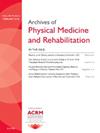有无虚拟现实技术的为期6周的跑步机训练对多发性硬化症患者虚弱程度的影响:多发性硬化症患者的虚弱康复。
IF 3.6
2区 医学
Q1 REHABILITATION
Archives of physical medicine and rehabilitation
Pub Date : 2025-02-01
DOI:10.1016/j.apmr.2024.09.010
引用次数: 0
摘要
目的研究由虚拟现实技术增强的跑步机训练(TT+VR)组成的认知运动康复项目对多发性硬化症患者(pwMS)虚弱程度的影响:设计:一项多中心随机对照试验的二次分析,该试验调查了TT+VR与仅进行跑步机训练(TT)相比,对多发性硬化症患者活动能力和认知功能的影响:以色列、美国和德国的四所大学研究实验室:共有 124 名 pwMS 被随机纳入母试验。在此,我们研究了83名参与者(平均年龄=49.4±9.3岁,73.5%为女性,EDSS范围=2.0-6.0),他们完成了干预,并拥有干预前后的完整虚弱数据:参与者被随机分配到 TT+VR 组(44 人)或 TT 组(39 人)。两组均每周训练三次,为期六周:通过标准的验证程序,使用 40 项虚弱指数(FI)对虚弱程度进行评估,这也是主要的研究结果。此外,还计算了两个探索性虚弱指数,方法是从主要虚弱指数中分离出与健康相关的认知(FI-体能)或体能(FI-认知)领域的缺陷。评估分别在基线和六周后,即干预完成时进行:研究参与者基线时的平均 FI 为 0.33±0.13,表明平均体弱程度为中等。TT+VR和TT参与者的FI评分均有所改善(汇总平均值ΔFI=0.024,95%CI=0.010-0.038,F=10.49,p=0.002,ηp2=0.115),没有任何组间时间交互作用(F=0.82,p=0.367,ηp2=0.010)。然而,训练前和训练后的 FI 认知变化存在明显的组间时间交互作用(F=5.74,p=0.019,ηp2=0.066),表明 TT+VR 参与者比 TT 参与者有更大的改善:结论:无论有无虚拟现实技术,跑步机训练都能减轻老年人的虚弱程度。虽然 TT 和 TT+VR 对总体虚弱程度都有积极影响,但只有 TT+VR 改善了虚弱程度的认知方面,可能是应对老年肌肉萎缩症患者虚弱程度的适当策略。本文章由计算机程序翻译,如有差异,请以英文原文为准。
Effects of a 6-Week Treadmill Training With and Without Virtual Reality on Frailty in People With Multiple Sclerosis
Objective
To examine the effects of a cognitive-motor rehabilitation program consisting of treadmill training (TT) augmented by virtual reality (TT+VR) on frailty in people with multiple sclerosis (pwMS).
Design
Secondary analysis from a multicenter randomized controlled trial investigating the effects of TT+VR, compared with TT only, on measures of mobility and cognitive function in pwMS.
Setting
Four university research laboratories in 3 countries.
Participants
A total of 124 pwMS were randomized into the parent trial. Here, we studied a subset of n = 83 participants (mean age, 49.4±9.3y; 73.5% female; expanded disability status scale range, 2.0-6.0), who completed the intervention and had complete preintervention and postintervention frailty data.
Interventions
Participants were randomly allocated to TT+VR (n=44) or TT (n=39). Both groups trained 3 times a week for 6 weeks.
Main Outcome Measures
Frailty was assessed using a 40-item frailty index (FI) through standard validated procedures and represented the primary study outcome. Two exploratory frailty indices were also computed by isolating health-related deficits involving the cognitive (FI-physical) or physical (FI-cognitive) domains from the main FI. The assessments were performed at baseline and after 6 weeks, upon intervention completion.
Results
The mean FI of study participants at baseline was 0.33±0.13, indicating a moderate average level of frailty. FI scores improved in both TT+VR and TT groups participants (pooled mean ΔFI, 0.024; 95% CI, 0.010-0.038; F=10.49; P=.002; ηp2=0.115), without any group-by-time interaction (F=0.82; P=.367; ηp2=0.010). However, a significant group-by-time interaction was found for pretraining and posttraining changes in FI-cognitive (F=5.74; P=.019; ηp2=0.066), suggesting a greater improvement for TT+VR group participants than for TT group participants.
Conclusions
TT with or without virtual reality can reduce frailty levels in pwMS. While both TT and TT+VR had a positive effect on overall frailty, only TT+VR improved cognitive aspects of frailty and may represent an appropriate strategy for counteracting frailty in pwMS.
求助全文
通过发布文献求助,成功后即可免费获取论文全文。
去求助
来源期刊
CiteScore
6.20
自引率
4.70%
发文量
495
审稿时长
38 days
期刊介绍:
The Archives of Physical Medicine and Rehabilitation publishes original, peer-reviewed research and clinical reports on important trends and developments in physical medicine and rehabilitation and related fields. This international journal brings researchers and clinicians authoritative information on the therapeutic utilization of physical, behavioral and pharmaceutical agents in providing comprehensive care for individuals with chronic illness and disabilities.
Archives began publication in 1920, publishes monthly, and is the official journal of the American Congress of Rehabilitation Medicine. Its papers are cited more often than any other rehabilitation journal.

 求助内容:
求助内容: 应助结果提醒方式:
应助结果提醒方式:


